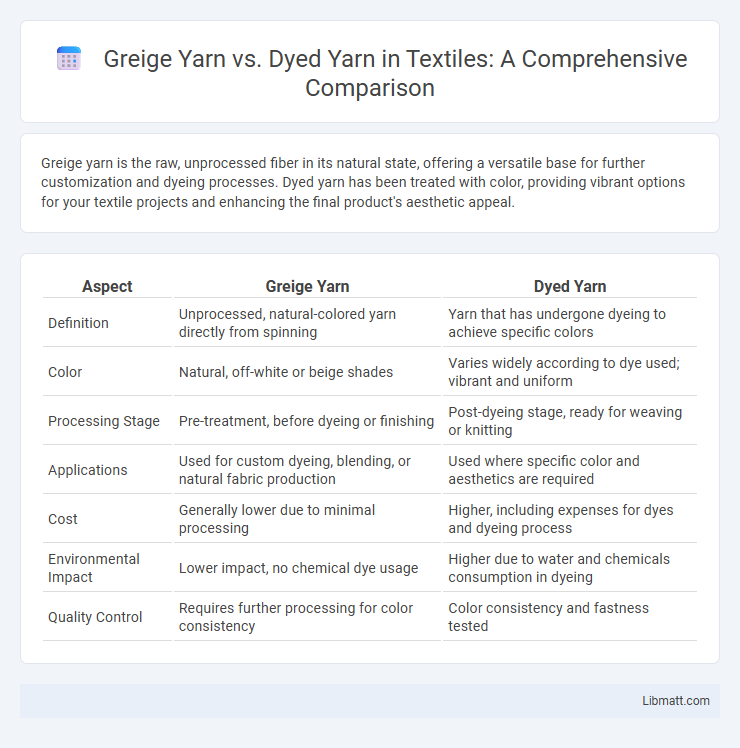Greige yarn is the raw, unprocessed fiber in its natural state, offering a versatile base for further customization and dyeing processes. Dyed yarn has been treated with color, providing vibrant options for your textile projects and enhancing the final product's aesthetic appeal.
Table of Comparison
| Aspect | Greige Yarn | Dyed Yarn |
|---|---|---|
| Definition | Unprocessed, natural-colored yarn directly from spinning | Yarn that has undergone dyeing to achieve specific colors |
| Color | Natural, off-white or beige shades | Varies widely according to dye used; vibrant and uniform |
| Processing Stage | Pre-treatment, before dyeing or finishing | Post-dyeing stage, ready for weaving or knitting |
| Applications | Used for custom dyeing, blending, or natural fabric production | Used where specific color and aesthetics are required |
| Cost | Generally lower due to minimal processing | Higher, including expenses for dyes and dyeing process |
| Environmental Impact | Lower impact, no chemical dye usage | Higher due to water and chemicals consumption in dyeing |
| Quality Control | Requires further processing for color consistency | Color consistency and fastness tested |
Introduction to Greige Yarn and Dyed Yarn
Greige yarn, also known as grey yarn, is the raw, unfinished fiber that has not undergone any dyeing or bleaching processes, retaining its natural color and texture. Dyed yarn, by contrast, has been treated with color pigments or dyes to achieve a specific hue, enhancing fabric aesthetics and allowing for diverse textile applications. Understanding the difference between your greige and dyed yarn is crucial for selecting the right material to match your design and production needs.
Understanding the Yarn Manufacturing Process
Greige yarn refers to the raw, unprocessed yarn that emerges directly from the spinning process, retaining its natural color and lacking any dye treatment. Dyed yarn undergoes an additional stage where color pigments or dyes are applied through methods such as package dyeing or hank dyeing, enhancing fabric aesthetics and meeting specific design requirements. The manufacturing process impacts yarn properties, with greige yarn requiring subsequent dyeing or finishing steps, while dyed yarn is ready for weaving or knitting into colored textiles.
What is Greige Yarn?
Greige yarn refers to the unbleached and undyed yarn directly obtained from the spinning process, retaining its natural color and impurities. This raw yarn serves as the foundational material for further dyeing, printing, or finishing treatments to achieve desired colors and textures. Understanding greige yarn helps you assess the quality and suitability of fabric before any coloration or processing begins.
What is Dyed Yarn?
Dyed yarn refers to fibers that have undergone a coloring process where pigments or dyes are applied to achieve specific hues and patterns, enhancing the yarn's aesthetic appeal. This process can be done at various stages, including fiber, yarn, or fabric level, allowing for vibrant and consistent color outcomes. Dyed yarn is preferred in textile manufacturing to create visually appealing fabrics suited for garments, upholstery, and home textiles.
Key Differences Between Greige and Dyed Yarn
Greige yarn is the raw, unprocessed fiber produced directly from spinning, retaining its natural color and texture, while dyed yarn undergoes color treatment to achieve specific hues and patterns. Greige yarn offers versatility for further textile processing, providing a blank canvas for customization, whereas dyed yarn delivers immediate visual appeal and color consistency for finished products. Your choice depends on whether you need customizable material for fabric production or ready-to-use yarn with specific color properties.
Advantages of Greige Yarn
Greige yarn, also known as grey or raw yarn, offers significant advantages such as cost-effectiveness since it bypasses the dyeing process, reducing production expenses and environmental impact. It maintains natural fiber strength and quality without exposure to chemical treatments or heat, resulting in higher tensile strength and better dye uptake for subsequent customization. The versatility of greige yarn allows manufacturers to tailor final colors and finishes, supporting sustainable textile production and minimizing waste.
Advantages of Dyed Yarn
Dyed yarn offers vibrant, consistent colors that enhance the aesthetic appeal and value of your textile products. It provides better colorfastness and resistance to fading compared to greige yarn, ensuring long-lasting vibrancy after multiple washes. Additionally, dyed yarn facilitates easier fabric customization, allowing precise matching to design specifications and fashion trends.
Environmental Impact: Greige vs Dyed Yarn
Greige yarn, being untreated and undyed, has a significantly lower environmental impact compared to dyed yarn, which involves resource-intensive processes such as water consumption, chemical usage, and energy for dyeing. The dyeing process generates toxic effluents and releases pollutants into water systems, increasing the ecological footprint. Choosing greige yarn reduces water pollution, chemical waste, and energy consumption, promoting sustainable textile production.
Applications and Uses in the Textile Industry
Greige yarn, unprocessed and natural, serves as a versatile foundation for diverse textile applications including knitting, weaving, and industrial uses where customization is essential. Dyed yarn, infused with vibrant pigments, is predominantly utilized in fashion, upholstery, and home textiles to achieve specific color aesthetics and design patterns. Both yarn types play crucial roles in manufacturing, with greige yarn enabling fabric customization and dyed yarn delivering immediate visual appeal in finished products.
Choosing the Right Yarn for Your Project
Greige yarn, being unprocessed and untreated, offers versatility and a natural, rustic texture ideal for eco-friendly or custom dyeing projects, allowing complete control over color and finish. Dyed yarn, pre-treated with color, provides consistency, saving time and ensuring vibrant, uniform hues perfect for immediate use in crafting and knitting. Selecting between greige and dyed yarn depends on your project's color requirements, texture preference, and whether customization or convenience is a higher priority.
Greige Yarn vs Dyed Yarn Infographic

 libmatt.com
libmatt.com